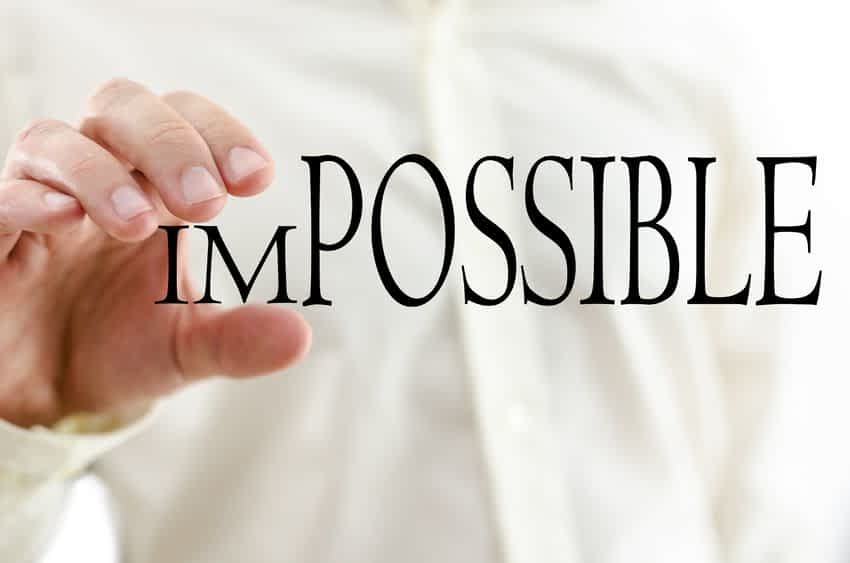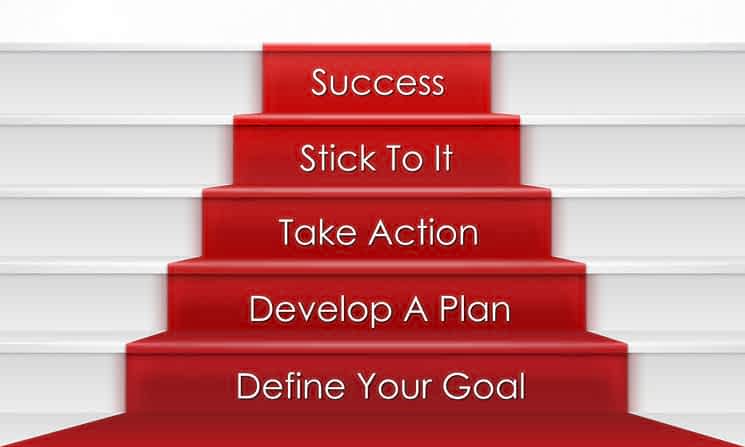
“Unlimiting Beliefs” Section Overview
Many of us have either been told limiting things by others, or else we have told them to ourselves. In some cases, they become rules by which we live our lives. “I’ll always be fat.” “I’ll always have to struggle to survive.” “I’m not good-looking.” “People aren’t attracted to me.” And so on. In one sense, we are very much like a computer. Our brains are programmed to protect us. The brain takes in information, and from this information it creates rules that it believes will protect & benefit us. They then become our O/S or Operating System, just like a computer. The good news is that you can overcome negative beliefs. In this section, I’ll present my 7-steps to eliminating them.
This section of the course is one of the most important of all of them, after Finding Motivation. The reason is that your beliefs create your world. If you believe that the world is out to get you, that life is hard, “no pain, no gain”, then that’s how your life will be for you. If you believe that you’ll never get fit, you’ll never lose weight, and you’ll always be struggling for money, then that’s how it will be.
Don’t get me wrong. I’m not saying you can just have a Pollyanna attitude and life’s treasures will fall at your feet. What I am saying, however, is that if you believe you can create a great life for yourself, and you make the efforts to make that happen, your life will get better.

In one sense, we are very much like a computer. Our brains are programmed to protect us. The brain takes in information, and from this information it extrapolates rules that it believes will protect & benefit us. They then become our O/S or Operating System, just like a computer. In addition, our brain will look for things in our life that validate our beliefs and will tend to ignore things that contradict our beliefs.
The bad news, according to many psychologists, is that most of our rules were created before the age of six, and largely without our knowledge or approval. People such as our parents and teachers, as well as television and movie personalities, and even our friends told us things that we accepted as truth. After that, we looked for examples in our lives that would validate those truths, and tended to ignore examples that invalidated them. These rules and beliefs to a large degree become who we are, or, more accurately, who we believe we are. The good news is that once we become aware of these rules, if we decide that they are wrong, we can change them.

One of the ways that we tend to keep our world “safe” is through cognitive biases. “Cognitive biases are tendencies to think in certain ways that can lead to systematic deviations from a standard of rationality or good judgment.”
What this means in plain language is that we tend to let our existing incorrect beliefs block evidence that they may be wrong even though common sense says those beliefs may indeed be wrong. Here are a few cognitive biases that you may be familiar with.
The Backfire Effect: When people react to disconfirming evidence by strengthening their beliefs. So if some evidence comes up that hunting animals is bad, and you’re a hunter, you may just dig in your heels, and say something like ”That’s a bunch of junk.” or “Damn tree-huggers!”
The Bandwagon Effect: The tendency to do (or believe) things because many other people do (or believe) the same. So if everyone else in your office believes that you’re all overworked, you will tend to go along with that belief. If they say the boss is a jerk, you’ll probably agree.
The Confirmation Bias: The tendency to search for, interpret, focus on and remember information in a way that confirms one’s preconceptions. So if you believe that a certain race tends to be lazy, for example, you will look for incidents that tend to reinforce this belief, and tend to ignore incidents that show your belief to be wrong.
Take a few minutes and look at an eye-opening list of cognitive biases at
https://en.wikipedia.org/wiki/List_of_cognitive_biases. See which ones you tend to use.
What’s the point of all this? The point is to show you that in some, or even many, instances the beliefs you have about the world may be inaccurate. The good news is as you examine your negative beliefs, you can really ask yourself “Are these beliefs really true?”
Like a computer, our brains can be reprogrammed. Once we become aware that incorrect beliefs are causing suffering in our lives, then we can examine them, and change them.
So the next time you sense a negative belief such as “I’ll always be fat” or “I’ll never be fit” or “I’ll always be broke”, just take a few minutes and ask yourself if this is really 100% true without any possible exception.
For more information on a practice to examine beliefs check out “The Work” by Byron Katie in my Personal Growth section of this course. You can also explore the process of EFT, also in my Personal Growth section of this course.
As you go through the rest of this course, as well as on my Website at GreatMiddleAge.com, I will show you ways that you can lose weight, that you can be fit and that you can eliminate poverty from your life. But it won’t do you any good to read about these topics or even try them out if you believe that they won’t work for you, because you’ll likely sabotage your efforts, as the results are not in your reality.

Interestingly, although I firmly believe in changing beliefs, this was a difficult section for me to write.
The first reason, to be honest, is that I rarely have limiting beliefs about myself and what I can do. Sure, I don’t believe that at age 74, I can begin to train for the Olympics and win a gold medal.
But I pretty-much believe I can do almost anything I set my mind to. And I don’t accept others’ limiting beliefs. Let me give you a couple of examples.
I didn’t start exercising until I was 58, when I began mountain biking. At age 64 I began doing indoor rock climbing, working up to climbing 1,500 feet a day, and with a 40-pound backpack. At age 69, I began working out at home with heavy kettlebells twice a week, and doing cardio every day.
Now at age 74, I have started going to the gym once a week in addition to my home kettlebell workouts, as I want to work my body from other angles. On top of that, I just started doing calisthenics and core workouts such as the “animal flow” movements, because I want an even higher level of fitness and energy. Let me be clear: I’m no “superman”. I just don’t have many limiting beliefs.
In another incident, for some time, I was experiencing what’s called atrial flutter, where, for example, I’ll just be sitting at my desk (or even sleeping), and my heart will suddenly speed up to maybe 150+ beats per minute, the same speed as if I were riding my mountain bike really fast. This has lasted as long as 24 hours in the past.
I went to see a cardiologist about it, and he started telling me that I’ll have it for the rest of my life, and I’d better start taking Coumadin, a very-strong drug, so strong that my blood would have to be monitored closely.
I frankly criticized him right to his face for trying to instill a limiting belief. I quoted the “Placebo” video on the TED talks
https://www.youtube.com/watch?v=LWQfe__fNbs, which besides showing how we can cure ourselves, points out how physicians can program us to believe we can’t.
Long story short, these days, I rarely have any flutter issues, and they usually only last an hour or so.
To learn more about this issue and others, check out the Natural Healing section of this course.

Here are some steps you can take to eliminate limiting beliefs.
1) The first thing to do is to discover the belief. If farther into this course, you’re reading my Physical Fitness section, and you find yourself thinking “I can’t do this. I’m too old”, then this is a limiting belief. Write it down on paper, or type it into a document on your computer.
Example: “I believe that at my age of 55 I’m too old to start exercising and I’ll never be fit”.
2) Search for the source of this belief. This may take some effort, and you may not be able to find the source, but give it a good try. Did somebody tell you this? Did your wife or girlfriend tell you “You’re too old to do that”? Did a friend tease you about it?
Was this something that your father instilled in you based on his talk and actions? Maybe when you asked him to go hiking with you one day, he responded “I’m too old for that”, even though he was only 50.
Or maybe you have tried to do something that you weren’t in shape for, struggled or failed, and then made a decision (programming, as I write about above) that you are too old for physical fitness.
See if you can recall when you first had this belief. If you can find it, write it down. If not, take your best guess.
Example: “I think I got this belief from my mom because she was never active once she hit her 50’s, and she always said ‘I’m too old for that”.
3) Realize that this belief isn’t true based on logic, not on what others have told you or you have misunderstood. Sure, if you don’t exercise at all and you try to do 20 pushups or go on a long hike in the mountains, you may fail.
But that doesn’t mean that you can’t start slow and build up and do these and other things. So think about the logic and realize that your “belief” may be wrong. Write down why this belief isn’t true.
Example: “Even though some people believe you can’t be fit once you hit middle age, there are lots of women and men who are these days”.
4) Create a belief that you can be successful at your goal. Now, I’m not saying that you can just change in an instant by writing it down, although it’s possible. What I am saying is for you to write down what you’d like your new belief to be.
Example: I’m able to exercise and be fit regardless of my age.
5) Think about what will be the benefit of achieving this goal. To do it because “I should” is pretty weak, and likely won’t cut it. Dig deeply, and think of reasons. When you hit one (or more) that you feel a positive emotion from, write it/them down. You should have some if you completed the first part of this course, “Finding Motivation”.
Examples: “When I work out I will feel happier and more energetic. I’ll have the energy to play with the grandkids. My wife will respect me.”
6) Begin your efforts to achieve your new belief. So, using our above example, start doing some exercise on a regular basis. You don’t have to start doing 2-hour intense workouts 3 times a week, nor should you. You’re likely to get discouraged quickly when you can’t move the day after your first workout, that is if you haven’t injured yourself in the process.
Start slow, and build up gradually. You’ll see more in the Physical Fitness section of this course, plus there will be good articles on my site at GreatMiddleAge.com.
Write down on your list what your starting action goal is.
Example: I’m going to do pushups and squats 3 mornings a week, and also go for a 20-minute walk on 3 of the other days.
Keep in mind that if you can’t do any regular pushups, you can do “knee pushups” or “wall pushups”. Here’s a video on that:
https://www.youtube.com/watch?v=Pkj8LLRsoDw
7) Create a “Success Log” where you keep record of your successes. For example, you could have a format like this:
| Week | Mon:Push | Tue:Walk | Wed:Push | Thu:Walk | Fri:Push | Sat:Walk | Sun:Break |
| 4/12 | 8 | 18 | 8 | 20 | 9 | 20 | 0 |
| 4/19 | 9 | 20 | 9 | 22 | 10! | 22 | 0 |
Then, for your pushup days, put down how many you did. For your walk days, put down how many minutes you walked. On Sunday, look over your log and see where you have failed, if at all. If you’ve done well, feel good about yourself, and that you’ve accomplished your goal!
After a few weeks, if you’re doing 10 pushups every day, then try to increase to 15 a day, or maybe do 10 pushups twice a day. If you’re walking 20 minutes every day, maybe shoot for 25 or even 30.
If you have “gotten with the program” that I suggest in the Physical Fitness section of this course, then you’ll have a fanbike and some kettlebells, and you’ll be able to really increase your efforts on a productive basis.

It has been said that we create our world. That sounds crazy, but think about this example. Different men and women seeing a Lamborghini Huracan Coupe ($237,000+) may have different perceptions of it.
One guy may see it as a beautiful object.
Another could see it as a well-made machine.
A third person might see it as a way to meet cute women.
An environmentalist might see it as a polluter.
A compassionate man might see it as a terrible waste of money that could help the poor.
A banker may think about the cost of financing it.
A mechanic might wonder how hard it would be to repair.
An insurance person could think about how much it would cost to insure.
An engineer may think about how the suspension would work.
A speedy driver would likely imagine racing other cars.
Which car is the real one?
All of them, depending on who is looking.
So, in a way, all of these people have “created” this car based on the value they have assigned to it.
My point is that since you “create” your world, you can be an active creator, and create a good one. Is the glass half-empty or half-full? Do you see trouble or a problem to be solved?

Just to be fair, some of you gals may swoon over this Hermes Matte Crocodile Birkin Bag, priced at $120,000, but most guys would just give you a “what!?” look if you told them the price, and remark something like “A hundred twenty thousand for a purse!”
So you see, it’s really all your point of view that determines your reality and beliefs.

Last night I was talking with a good friend I’ve known for more than 35 years. He has been fighting cancer for over 6 years, and so far has been successful, although he has a lot of discomfort and will probably have to take medication the rest of his life.
We were talking about different healing methods, and how some don’t work, and in his rant, he said something like “…and all of that energy healing bullshit is a waste of time.”
So he has closed his mind and life to this kind of healing. If you go to
emofree.com/index.php?q=cancer&option=com_finder&view=search&lang=en-US&Itemid=219 , you can read 179 articles on people helped with cancer, some of whom were “cured”. Now, I’m not saying EFT can cure his cancer, but I am saying that if he doesn’t try it, then for certain it won’t help.
I know this guy pretty-well, and know that he has had a lot of worries about his business for years, as well as a lot of anger towards governmental regulations. He is angry against Google, Amazon, Democrats, environmentalists, etc. Worry and anger can definitely contribute to causing cancer.
But, he believes that energy healing can’t help, and so it never will help him unless he changes his beliefs. Sad.
If you’d like to watch a great video on how one’s beliefs can profoundly affect their body. In the video, a medical doctor tells the story of a man with advanced cancer, who made orange-sized tumors go away, come back and then go away again. https://www.youtube.com/watch?v=LWQfe__fNbs .
If you’d like more, you can watch the following video by Dr. Bruce Lipton, where he talks about how our beliefs change our body:
https://www.youtube.com/watch?v=jjj0xVM4x1I

Sometimes imagining ahead does give us a beneficial effect, and that’s OK. But energy spent imagining how we’d really crush somebody we don’t like is a waste. Or, imagining countless other possible problems from getting stuck in traffic to losing our job, and how we’d deal with them.
The funny part is that if they happen, we likely won’t deal with them in the way we’d imagine anyway, so we’d have wasted a lot of energy for nothing.
Years ago, I created a term I call “IFEAR”. Besides meaning “I fear”, it’s an acronym meaning “Imagined Future Events Appearing Real”. Let’s be realistic: most of these imagined events never come to be, and if they do, they rarely happen as we’d imagined they would. A wise man once said “I have had many problems in my life, most of which have never happened”.
Active Action: To help to eliminate these wastes of energy and peace, try to become aware of when you are having these imaginary battles. When I started this process, if I realized I was doing this, I said to myself “dragons”, which meant I was imagining fighting a dragon, which, of course, doesn’t exist.
I then dismissed this issue from my mind. As I did this practice more and more, I got better at stopping it earlier in the process. These days, I can pretty-much stop these mental arguments in the first 20 seconds or less.
Benefits: The immediate benefit is that you will start to have more peace of mind and body. The longer-term benefit is that you will become more and more aware of your mind and its activities, and thus be more able to eliminate unskillful actions. To learn more about being aware of your mind and its actions, check out the Mindfulness Meditation information in the Personal Growth section of this course.

One of the most important influencing factors in my life has been the realization that everything works out perfectly in life. Now, I need to make it very clear that this was indeed a realization.
It was not something I read in some book, nor was it something someone told me. It was something that I realized through observation of my own life.
The reason that this is one of the most important factors, is that once I realized this, a huge burden was lifted from my shoulders. The reason was that I no longer felt stressed out that there were a lot of things that I had to do in order to make life go correctly.
Now, this doesn’t mean that all of a sudden I started lying around all day watching YouTube. I still went forward. I still had goals. In a way, from an outside view my life looked exactly the same as it did previously. But from the inside, everything was different because the fear and worry were gone.
Sometimes it takes a while to see why something “bad” was actually good. Maybe something got delayed, which seemed bad, but actually it got delayed until the perfect situation became available.
Let me give you an example. A few years ago, I had been trying to sell my late brother’s house for over a year, and finally, I had an offer from a pre-approved buyer. However, because the mortgage holder for the house dragged their feet, the buyer’s offer expired.
This looked bad, but four months later I had a cash buyer, and wound up getting a lot more for the house than I would have if the first buyer had purchased it.
And so I have seen that everything works out perfectly, and I am supported especially when I am doing the right thing, that is doing things that are beneficial to others.
I also believe that we connect with the people with whom we are supposed to. I see it happen in my life over and over. Just this past week, on two separate occasions, I “just happened” to run into two people that I had been wanting to speak with, but had no way of reaching.
So after observing everything working perfectly, opportunities just popping up at the right time, and running into people with whom I needed to connect with no effort on my part, I sort of had the feeling that this world is like a clock mechanism.

As you can see in the above image, one gear meshes with another gear, which meshes perfectly with yet another gear, and the whole mechanism works as one entity, even though it is made up of many separate parts. In the same way, when we are “in sync”, we run into exactly who were supposed to, and events happen perfectly and at exactly the right time.
One of the things that I have had to deal with in accepting this philosophy is that if it’s true, it’s always true. It doesn’t make sense that when things go well, I get all excited about how everything’s perfect, and then when things don’t go well, I think to myself “Well, sometimes things work out perfectly, and sometimes not.” Either the principle is true, or it’s not true. So I’ve decided to accept that it’s always true, even when I don’t understand things. If I have negative emotions that are bothering me, I use EFT, which I refer to in the Personal Growth section of this course, as well as on my Website at GreatMiddleAge.com.

So, once I shifted my perspective, and held the belief that everything worked out perfectly, I had this sense of peace and positive expectation. What I then started to notice, is that I would get “hints” about what to do.
Sometimes it would just be a thought that popped into my head. Other times, it would be something someone said to me, something I saw on the Internet, or even something I might see in a store.
At this point, you may well ask “Where do these hints come from?” My answer is “I honestly don’t know”. Some people would say they come from God or from some “holy” source. Others would say they come from the Universe, the One, or other names for a Divine source.
I do know that they don’t come from some evil source because they always produce benefits for others as well as for myself. All I know is that when I am trusting, have positive thoughts and expect good things in life, everything works out perfectly, even f it doesn’t seem so at the time.
Now, you may well ask “What about all of the bad things that happen in life, like children dying, people getting killed, etc.?” On the surface, these events appear to refute the concept that everything works out perfectly.
I can’t explain why everything happens, and some things seem so horrible that there can be no good reason for them. But I have seen situations where, for example, a child dies, but their death leads to the establishment of a new organization to help prevent that problem in the future. Even environmental crises may pave the way for people to work together.
And yet, if one digs deeply, many people believe that a Divine energy, sometimes called the “Tao”, controls this universe. I won’t argue whether that is done by an anthropomorphic entity, whether that Energy just works this way. But I ask you “If you believe that a Divine energy controls this world, who are you to judge how it works and what is done?”
Some religions and philosophies believe that people come to this world with certain things to accomplish, including interacting with the people who they meet.
Furthermore, they believe that once these things have been accomplished, that the person who did them will then leave this material world. Some live long lives; others short ones. It seems especially harsh when people die young, we don’t know the overall plan.
Elisabeth Kubler-Ross, a famous pioneer in her work with death and dying once said “When we have passed the tests we are sent to Earth to learn, we are allowed to graduate. We are allowed to shed our body, which imprisons our souls.”
She also said “Death is simply a shedding of the physical body like the butterfly shedding its cocoon. It is no different from taking off a suit of clothes one no longer needs.” Philosopher Alan Watts once said “What if this life is a dream and when we die, we wake up?’
So I propose that instead of being fearful and looking for all the negativity in the world, that you might see it as a sort of “school”, where you are loved by your teachers, and learn the lessons you need to know.
Of course, even though you see this world as perfect, that doesn’t mean you don’t make efforts to change things that you feel are wrong. You may put 100% energy into your efforts. It only means that you are not attached to the outcome of your efforts, although you may continue working hard to accomplish your desired goal, even when your efforts fail.
I hope that these ideas have brought you some peace in your life. Likely some of them are new to you and may have made you feel uncomfortable. That’s OK. There’s no need to rush, but do keep in mind that it’s your mind’s programming to beware of strange new things, so consider expanding your comfort zone and exploring a bit. You’ll be glad you did!
Now that you’ve found motivation in the first section of this course, and have just now learned how to get rid of limiting beliefs, it’s time to learn how to create happiness, which is the next section. See you there!